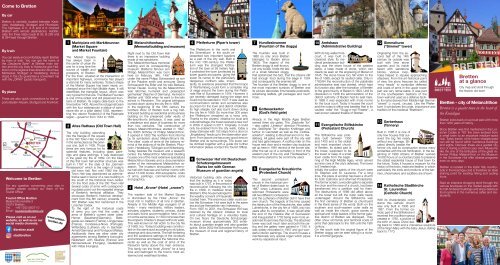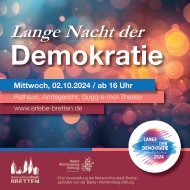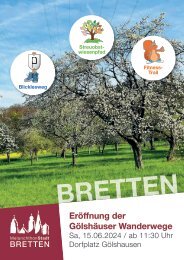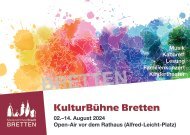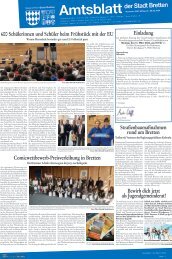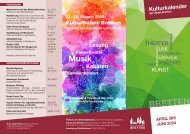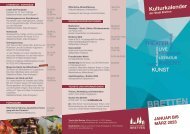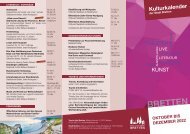Bretten at a glance
City map and stroll through the historic old town.
City map and stroll through the historic old town.
You also want an ePaper? Increase the reach of your titles
YUMPU automatically turns print PDFs into web optimized ePapers that Google loves.
Come to <strong>Bretten</strong><br />
By car<br />
<strong>Bretten</strong> is centrally loc<strong>at</strong>ed between Karlsruhe,<br />
Heidelberg, Stuttgart and Pforzheim.<br />
The highways A 5, A 8 and A 6 connect<br />
<strong>Bretten</strong> with remote destin<strong>at</strong>ions. Additionally<br />
the three st<strong>at</strong>e roads B 35, B 293 and<br />
B 294 lead through <strong>Bretten</strong>.<br />
By train<br />
You can easily and comfortably reach <strong>Bretten</strong><br />
by tram or train. You can get the trains of<br />
the „Deutsche Bahn“ <strong>at</strong> <strong>Bretten</strong> main st<strong>at</strong>ion<br />
and the city lines to Karlsruhe and Heilbronn<br />
or the regional lines direction Bruchsal,<br />
Mühlacker, Stuttgart or Heidelberg. Various<br />
stops in the city guarantee a convenient trip<br />
with the „ÖPNV” (public transport).<br />
By plane<br />
There are also quick connections to the airports<br />
Baden-Airpark, Stuttgart and Frankfurt.<br />
Welcome to <strong>Bretten</strong><br />
For any question concerning your stay in<br />
<strong>Bretten</strong> please contact our team of the<br />
Tourist Office:<br />
Tourist Office <strong>Bretten</strong><br />
Melanchthonstraße 3<br />
75015 <strong>Bretten</strong><br />
Tel: +49 7252 58371 0<br />
Email: touristinfo@bretten.de<br />
Please visit us on our<br />
website, as well as on our<br />
social media channels.<br />
@bretten.stadt<br />
stadtbretten<br />
www.erlebebretten.de<br />
1<br />
2<br />
Marktpl<strong>at</strong>z mit Marktbrunnen<br />
(Market Square<br />
and Market Fountain)<br />
The Market Square<br />
has always been in<br />
the center of urban life<br />
and for a long time the<br />
source of wealth and<br />
prosperity of <strong>Bretten</strong>.<br />
For the town, situ<strong>at</strong>ed <strong>at</strong> the intersection of<br />
important highways, commerce has played<br />
a vital role for many centuries. Today’s shape<br />
of the Market Square has been nearly unchanged<br />
since the High Middle Ages. It still<br />
resembles the triangular layout, which was<br />
very typical for th<strong>at</strong> era. The Market Fountain<br />
is one of the oldest and still preserved fountains<br />
of <strong>Bretten</strong>. Its origins d<strong>at</strong>e back to the<br />
time before 1400. Above the octagonal basin<br />
with the four w<strong>at</strong>erspouts a st<strong>at</strong>ue of sandstone<br />
sits on a pillar d<strong>at</strong>ed 1555, representing<br />
the elector Frederick II of the Pal<strong>at</strong>in<strong>at</strong>e<br />
region – governor from 1544 to 1556.<br />
Altes R<strong>at</strong>haus (Old Town Hall)<br />
The only building extending<br />
into the triangle of the square<br />
is the Old Town Hall, loc<strong>at</strong>ed<br />
in the same place as the previous<br />
one, built in 1435. Those<br />
times are very famous for its<br />
splendid fe<strong>at</strong>ures, including glass paintings<br />
and glass etchings. It was destroyed<br />
in the gre<strong>at</strong> city fire of 1689. On the base<br />
of this first town hall another structure was<br />
built in 1787 in the style of the „Germain<br />
Renaissance“ which is the origin of today’s<br />
old town hall. Not until 1982 the Old<br />
Town Hall was abandoned as administr<strong>at</strong>ive<br />
se<strong>at</strong> in favour of a new building in<br />
the south of the historical town center.<br />
On the front side of the Old Town Hall<br />
several co<strong>at</strong>s of arms with corresponding<br />
d<strong>at</strong>es point out the repe<strong>at</strong>ed change<br />
of <strong>Bretten</strong>’s territorial affili<strong>at</strong>ion. They<br />
showcase <strong>Bretten</strong>’s historical development<br />
from the 8th century onwards. In<br />
767 <strong>Bretten</strong> was first mentioned in the<br />
Lorscher Codex.<br />
To the right of the historical co<strong>at</strong>s<br />
of arms you can find the co<strong>at</strong>s of<br />
arms of <strong>Bretten</strong>’s current sister cities:<br />
Hemer (Sauerland/Germany), Bellegarde-sur-Valserin<br />
(France), Longjumeau<br />
(France), Condeixa-a-Nova (Portugal),<br />
Wittenberg (Lutheran city in Sachsen-<br />
Anhalt/Germany) and Pontypool (Wales).<br />
Additionally there are other sister city<br />
agreements among <strong>Bretten</strong>’s boroughs:<br />
Neibsheim with Neuflize (France) and<br />
Nemesnaduvar (Hungary), Diedelsheim<br />
with Hidas (Hungary).<br />
3<br />
Melanchthonhaus<br />
(Memorial building and museum)<br />
Right next to the Old Town Hall<br />
there is an impressive building<br />
made of red sandstone:<br />
The Melanchthonhaus memorial<br />
building and its corresponding<br />
museum. <strong>Bretten</strong>’s famous son<br />
Philipp Melanchthon was born<br />
here on February 16th, 1497<br />
under the name Philipp Schwarzerdt as son<br />
of the Pal<strong>at</strong>ine smith and armourer Georg<br />
Schwarzerdt the Elder and his wife Barbara,<br />
former Reuter. During his life Melanchthon<br />
was reformer, humanist and „praeceptor<br />
germaniae“ (Teacher of Germany). He lived in<br />
<strong>Bretten</strong> until 1508 when he went to the l<strong>at</strong>in<br />
school in Pforzheim. The original birthplace<br />
burned down during the city fire in 1689.<br />
In the beginning of the 18th century the<br />
brothers Würz of <strong>Bretten</strong> built a big halftimbered<br />
building as residential and business<br />
building on the preserved cellar vaults of<br />
Me-lanchthon’s birthplace. It was used as<br />
a residence and place of business for more<br />
than two centuries. The construction of<br />
today’s Melanchthonhaus started in 1897,<br />
the 400th birthday of Philipp Melanchthon.<br />
It opened in 1903.The northern front informs<br />
by its symbolism about Melanchthon’s life.<br />
The cities’ co<strong>at</strong>s of arms <strong>at</strong> the balcony remind<br />
of the st<strong>at</strong>ions of his life: <strong>Bretten</strong>, Pforzheim,<br />
Heidelberg, Tübingen and Wittenberg.<br />
Today, besides the museum and a research<br />
center, the Melanchthon Memorial Building<br />
houses one of the most extensive specialized<br />
Melanchthon libraries and a document<strong>at</strong>ion<br />
center of the intern<strong>at</strong>ional Melanchthon research.<br />
The museum showcases a memorial<br />
hall with frescoes and further rooms with<br />
about 13.000 books, 490 autographs, co<strong>at</strong>s<br />
of arms, paintings, commemor<strong>at</strong>ive coins<br />
and graphics.<br />
4<br />
Hotel „Krone“ (Hotel „crown”)<br />
The western side of the Market Square<br />
is domin<strong>at</strong>ed by the Hotel „Krone” the<br />
most rich in tradition of all inns in <strong>Bretten</strong>.<br />
Already in the Middle Age voyagers of all<br />
kinds – many merchants, military leaders,<br />
scholars, pilgrims, students, princes, dukes<br />
and earls found accommod<strong>at</strong>ion here, in an<br />
inn <strong>at</strong> the same place. In 1550 none less than<br />
the emperor Charles V stayed within its walls.<br />
This well-known inn fell victim to the city fire<br />
of 1689, too. Today’s building was constructed<br />
on the same spot according to old plans,<br />
drawings and documents. The half-timbering<br />
and the sandstone settings of the windows<br />
and entrances emphasize the historical character<br />
as well as the co<strong>at</strong> of arms of the<br />
Paravicini family above the main entrance.<br />
This family ran the Hotel „Krone” for a long<br />
time and belonged to the town’s most esteemed<br />
and wealthiest families.<br />
5<br />
Pfeiferturm (Piper’s tower)<br />
The Pfeiferturm in the north and<br />
the Simmelturm in the south represented<br />
two important bastions<br />
as a part of the city wall. Built in<br />
the mid 13th-century the Pfeiferturm<br />
was the strongest fortific<strong>at</strong>ion<br />
of the town <strong>at</strong> 26 meters high.<br />
It protected the town (protected by<br />
tower guards and pipers, giving the<br />
tower its name) to the particularly<br />
dangerous northern side. Importantly,<br />
its existence prevented th<strong>at</strong> the troops<br />
of Württemberg could form a complete ring<br />
of siege around the town during the Pal<strong>at</strong>in<strong>at</strong>e<br />
War of Succession in 1504. However, it<br />
got severely damaged during the siege and<br />
could only be restored in 1507. It was used as<br />
communic<strong>at</strong>ion center and sometimes also<br />
as prison for the town and district of <strong>Bretten</strong>.<br />
Its high steeple roof also burnt down during<br />
the city fire in 1689. So more than 300 years<br />
the Pfeiferturm remained as a torso only.<br />
Thanks to the citizens’ initi<strong>at</strong>ive for local and<br />
cultural heritage, the tower received a new roof<br />
in 2009. It opend in 2017. Originally, it could<br />
only be entered from the city walls, today a<br />
steep staircase with 152 steps from a door on<br />
„Engelsberg“ leads up to the observ<strong>at</strong>ion pl<strong>at</strong>form.<br />
From above one has a very good view on<br />
<strong>Bretten</strong> and its surroundings. The tower can<br />
be climbed together with a guide (for further<br />
inform<strong>at</strong>ion please contact the Tourist Office).<br />
6<br />
Schweizer Hof mit Deutschem<br />
Schutzengelmuseum<br />
(Swiss Inn with German<br />
Museum of guardian angels)<br />
Historical building d<strong>at</strong>a shows<br />
th<strong>at</strong> the building as it is today<br />
was built in 1707, in the period of<br />
reconstruction following the city<br />
fire in 1689. In medieval times<br />
<strong>Bretten</strong>’s tithe house belonged to<br />
the wealthy convent of Frauenalb<br />
loc<strong>at</strong>ed here. The enormous cellar vaults below<br />
the Schweizer Hof were built in the same<br />
era and are themselves very interesting.<br />
From 1997 to 2001, the Schweizer Hof was<br />
restored by the citizens’ initi<strong>at</strong>ive for local<br />
and cultural heritage on a voluntary basis.<br />
On two floors the Deutsche Schutzengelmuseum<br />
shows approxim<strong>at</strong>ely 300 exhibits<br />
about guardian angels and also guardian<br />
spirits. Since 2002 the Schweizer Hof houses<br />
the museum of local and regional history of<br />
<strong>Bretten</strong>.<br />
7<br />
Hundlesbrunnen<br />
(Fountain of the doggy)<br />
The fountain was built in<br />
1880 so only once <strong>Bretten</strong><br />
belonged to Baden (since<br />
1803). The legend of the<br />
<strong>Bretten</strong> doggy is well-known,<br />
not only locally. It tells the tale<br />
of a small f<strong>at</strong>tened doggy,<br />
th<strong>at</strong> epitomized the fact, th<strong>at</strong> the citizens still<br />
had enough food during the siege in 1504<br />
and consequently the enemies left.<br />
The fountain of the <strong>Bretten</strong> doggy is one of<br />
the most important symbols of <strong>Bretten</strong> and<br />
its picture decor<strong>at</strong>es innumerable postcards,<br />
advertising leaflets, gift packages and much<br />
more.<br />
8<br />
Gottesackertor<br />
(God’s field g<strong>at</strong>e)<br />
Already in the High Middle Ages <strong>Bretten</strong><br />
owned three city g<strong>at</strong>es. The „Salzhofer Tor“<br />
– also called „Untertor“ direction Pforzheim,<br />
the „Weißhofer Tor“ direction Knittlingen and<br />
furthur to Cannst<strong>at</strong>t as well as the „Gottesackertor“,<br />
leading to Bruchsal and on to Heidelberg.<br />
All g<strong>at</strong>es were part oft the city wall<br />
and had g<strong>at</strong>e keepers. A rooftop rider on the<br />
house next door and a modern clay sculpture<br />
set up here in 1991 remind of the former site.<br />
After the set up of a cemetery in front of the<br />
western part of the city wall (“Gottesacker”),<br />
this name started to be commonly used.<br />
9<br />
Evangelische Kreuzkirche<br />
(Protestant Church)<br />
This second protestant<br />
church in the historical center<br />
of <strong>Bretten</strong> d<strong>at</strong>es back to<br />
1687 when Lutherans and<br />
reformed Protestants were<br />
still two different confessions<br />
and the Lutherans of <strong>Bretten</strong> didn’t have their<br />
own church. The tragedy of the time caused<br />
the destruction of the Kreuzkirche, also called<br />
Lutherkirche, in the city fire of 1689, only two<br />
years after its completion. It was rebuilt after<br />
the end of the Pal<strong>at</strong>ine War of Succession<br />
and inaugur<strong>at</strong>ed in 1702 being even more unadorned<br />
those times than today. The <strong>at</strong>tached<br />
tower was built much l<strong>at</strong>er and both the ceiling<br />
and the gallery were painted in 1740. It<br />
was widely renov<strong>at</strong>ed in 1957 and got wonderful<br />
interior paintings. The church houses a<br />
mechanically very special organ which pipes<br />
work by separ<strong>at</strong>e air input.<br />
10<br />
Amtshaus<br />
(Administr<strong>at</strong>ive Building)<br />
With its big walled forecourt,<br />
it was built in<br />
classicist style. Its medieval<br />
predecessor building<br />
was the stone house of the pal<strong>at</strong>ine<br />
reeve, a keep made of stone, which can<br />
clearly be seen on the engraving of Merian of<br />
1645. The stone house too, fell victim to the<br />
fire of 1689, except its vaulted cellar. Only in<br />
1783/84 the reconstruction of the pal<strong>at</strong>in<strong>at</strong>e<br />
administr<strong>at</strong>ive se<strong>at</strong> was started, which kept<br />
its function also after the transition of <strong>Bretten</strong><br />
to the grand duchy of Baden in 1803. Until its<br />
dissolution in 1936 the administr<strong>at</strong>ion of the<br />
district authority of Baden had its se<strong>at</strong> here.<br />
In 1888 it was expanded with more rooms<br />
for the local court. Today it houses the court<br />
and the notary’s office and besides th<strong>at</strong> in its<br />
vaulted cellar the “Gugg-e-mol-The<strong>at</strong>er”, a<br />
well-known cabaret the<strong>at</strong>re of <strong>Bretten</strong>.<br />
11<br />
Evangelische Stiftskirche<br />
(Protestant Church)<br />
The Stiftskirche was probably<br />
built between 1350<br />
and 1400 and is the oldest<br />
and most important church<br />
of <strong>Bretten</strong>. Its oldest part is<br />
the tower, supposed to be<br />
the tower or keep of a small<br />
town castle from the beginning<br />
of the High Middle Ages, which served<br />
as inner core of the city’s defenses. The tower<br />
is 61meters high.<br />
Initially the p<strong>at</strong>ron saints of the church were<br />
St. Stephen and St. Laurence. For a long<br />
time, this place of worship has been a church<br />
for both C<strong>at</strong>holics and reformed Protestants.<br />
The former screen, a wooden g<strong>at</strong>e to separ<strong>at</strong>e<br />
the choir and the nave of a church, had been<br />
transformed into a partition wall for them.<br />
The destructions of 1689 did affect above<br />
all the tower but left the outer walls nearly<br />
undamaged. Around the Stiftskirche was<br />
the first cemetery of <strong>Bretten</strong> (a churchyard<br />
in the literal sense of the word). Both on the<br />
southern and south-eastern outer walls as<br />
well as inside the church, grave stones of<br />
spiritual and noble leaders of the former pal<strong>at</strong>ine<br />
district of <strong>Bretten</strong> are displayed. They<br />
often show old family and territorial co<strong>at</strong>s of<br />
arms th<strong>at</strong> d<strong>at</strong>e back to the 16th until the 18th<br />
century.<br />
On the south side the original figure of the<br />
<strong>Bretten</strong> doggy can be seen sitting in a niche.<br />
It is a former gargoyle.<br />
12<br />
Simmelturm<br />
(“Simmel” tower)<br />
Origin<strong>at</strong>ing from the second<br />
half of the 14th<br />
century its outside was<br />
built with lime stone<br />
quarries and its inside<br />
faced with sandstone<br />
blocks. Various loopholes<br />
helped to repulse approaching<br />
<strong>at</strong>tackers. From the art-historical point<br />
of view, the stony frescoes (so called<br />
“envy heads” to symbolize defense)<br />
and co<strong>at</strong>s of arms in the upper tower<br />
part are very remar-kable. It was part<br />
of the southeastern bastions of the<br />
town-wall and used as a defense facility.<br />
Its name derives from Middle High German<br />
“sinwel” (= round, circular). Like the Pfeiferturm<br />
it symbolizes the pride, importance and<br />
tradition of the medieval “Brettheim”.<br />
13<br />
Gerberhaus<br />
(Tannery)<br />
Built in 1585 it is one of<br />
only few houses th<strong>at</strong> survived<br />
the big fire nearly<br />
without any damage. Situ<strong>at</strong>ed<br />
directly beside the<br />
former city wall its construction shows many<br />
similarities with the old fortific<strong>at</strong>ion. In the beginning<br />
of 1990 citizens of <strong>Bretten</strong> worked<br />
14.000 hours on a voluntary basis to preserve<br />
the oldest residential house of their town for<br />
the future. Today it houses a museum for the<br />
history of the town, trade and le<strong>at</strong>her, in which<br />
particularly the tools and products of the tanners,<br />
shoemakers and saddlers are shown.<br />
14<br />
K<strong>at</strong>holische Stadtkirche<br />
St. Laurentius<br />
(C<strong>at</strong>holic Church)<br />
With its characteristic onion<br />
dome this c<strong>at</strong>holic church<br />
was only built in 1936 and<br />
1937. From the former c<strong>at</strong>holic<br />
part of the Stiftskirche it<br />
received the crucifixion group<br />
cre<strong>at</strong>ed in 1780, a picture of<br />
the birth of Jesus Christ d<strong>at</strong>ing<br />
back to 1680 and a marvelous sculpture<br />
of the Virgin Mary with the baby Jesus, d<strong>at</strong>ing<br />
back to 1770.<br />
<strong>Bretten</strong><br />
<strong>at</strong> a <strong>glance</strong><br />
City map and stroll through<br />
the historic old town<br />
<strong>Bretten</strong> - city of Melanchthon<br />
<strong>Bretten</strong> is a quaint town in the heart of<br />
the Kraichgau<br />
<strong>Bretten</strong> looks back on a proud past with more<br />
than 1250 years of history.<br />
Since <strong>Bretten</strong> was first mentioned in the Lorscher<br />
Codex in 767 the town evolved from<br />
a small town to an important medium-sized<br />
hub. Today tracks of its history-charged past<br />
can still be found within numerous buildings<br />
and sights. Discover these via a guided city<br />
tour or during a stroll on your own. Museums<br />
like the one of the birthplace of the gre<strong>at</strong> reformer<br />
Philipp Melanchthon or the Museum<br />
in the Schweizer Hof offer diverse programs<br />
even on rainy days.<br />
<strong>Bretten</strong> is loc<strong>at</strong>ed in the idyllic hilly countryside<br />
in the Kraichgau and is therefore an ideal<br />
starting point for exciting hiking and cycling<br />
tours.<br />
Start an intensive shopping stroll through the<br />
various boutiques on the market square with<br />
its half-timbered buildings and enjoy delicious<br />
food options in the numerous cafes and restaurants.
Arriving in <strong>Bretten</strong><br />
Parking<br />
P1<br />
P2<br />
P3<br />
P4<br />
P5<br />
P6<br />
Parkhaus Pfluggasse<br />
Parkpl<strong>at</strong>z Sporgasse<br />
Parkhaus Engelsberg<br />
Parkhaus Löwenhof<br />
Parkpl<strong>at</strong>z Seedamm<br />
Parkpl<strong>at</strong>z Behördenzentrum<br />
Discover <strong>Bretten</strong><br />
People – Places – History<br />
Discover <strong>Bretten</strong> – its wonderful old town,<br />
unique flair and history-charged past. You<br />
can do this on your own by using the pocket<br />
plan.<br />
Or do you want a little more inform<strong>at</strong>ion?<br />
Our competent city guides are pleased to<br />
inform you about <strong>Bretten</strong>’s history. We like<br />
to organize your individual tour whether you<br />
choose a guided tour through the old town,<br />
a stroll with the towerwoman, a special topic<br />
tour refering to Melanchthon or a visit of the<br />
German Museum of Guardian Angels.<br />
Adventure, culture or<br />
pure n<strong>at</strong>ure<br />
Enjoy <strong>Bretten</strong> with all your senses<br />
Escape from everyday stress, recharge your<br />
health and joy of life in <strong>Bretten</strong> and the feelgood<br />
region Kraichgau-Stromberg. Have<br />
fun, experience exciting adventure, dive into<br />
worlds of reading and the<strong>at</strong>re or just allow<br />
yourself a short break. In <strong>Bretten</strong> you will find<br />
the corresponding offer for all your moods:<br />
• Hiking and cycling<br />
• Spa world <strong>Bretten</strong><br />
• Climbing park with zip-line courses<br />
• <strong>Bretten</strong> Zoo<br />
• Multi-gener<strong>at</strong>ion park and playgrounds<br />
• Kinostar <strong>Bretten</strong> (cinema)<br />
• Badische Landesbühne (the<strong>at</strong>re) and<br />
the Gugg-e-mol-The<strong>at</strong>re (cabaret<br />
the<strong>at</strong>re)<br />
• Public Library and much more<br />
<strong>Bretten</strong> celebr<strong>at</strong>es<br />
The city lives its history<br />
<strong>Bretten</strong> knows how to celebr<strong>at</strong>e which becomes<br />
most apparent during the annual<br />
Peter-and-Paul-Festival in the beginning of<br />
July. The city presents its history on a journey<br />
through time during the siege by the troops of<br />
Württemberg in 1504.<br />
The hustle and bustle of 4.000 historically<br />
dressed participants invite the visitors to look,<br />
to marvel and to take part. Scenic performances<br />
and a colorful camp life of lansquenets,<br />
city guards, craftsmen and farmers give<br />
insight of the everyday life in a medieval town.<br />
Musicians, jugglers, herald trumpets and militia<br />
offer a diverse program.<br />
The Peter-and-Paul-Festival is well-known in<br />
the region and beyond and was awarded as<br />
„Imm<strong>at</strong>erial Culture Heritage“ in 2014.<br />
For further inform<strong>at</strong>ion regarding the Peterand-Paul-Festival<br />
and exact d<strong>at</strong>es please<br />
use: www.peter-und-paul.de<br />
Experience <strong>Bretten</strong><br />
Culture –Events – Markets<br />
Annually <strong>Bretten</strong> also offers a diverse program<br />
of events – readings, the<strong>at</strong>re, markets<br />
and also music events. There is something for<br />
everyone.<br />
During the program „Summer in the Park“,<br />
the city park becomes a stage alive every two<br />
years. Many events – the<strong>at</strong>re, music, liter<strong>at</strong>ure<br />
and sports take place in a relaxed <strong>at</strong>mosphere.<br />
Another highlight is the wine market in the end<br />
of September, where winemakers of Baden<br />
and Württemberg offer their fine wines and<br />
seasonal delicacies in comfortable pergolas.<br />
Finally, the traditional Christmas market combined<br />
with arts and crafts market invites to<br />
come to <strong>Bretten</strong>.<br />
PICTURE CREDITS<br />
Bernhard Brenner, Comauthor/stock.adobe.com, Peter Fernsel, Fotolia/<br />
fotolia.com, P<strong>at</strong>rick Lang, Valentina Morschhauser/Semo-Gestaltung,<br />
Thomas Rebel/rebel-shotz.com, Corinna Stein<br />
GRAPHICS AND MAP<br />
Werbeagentur Plan B


